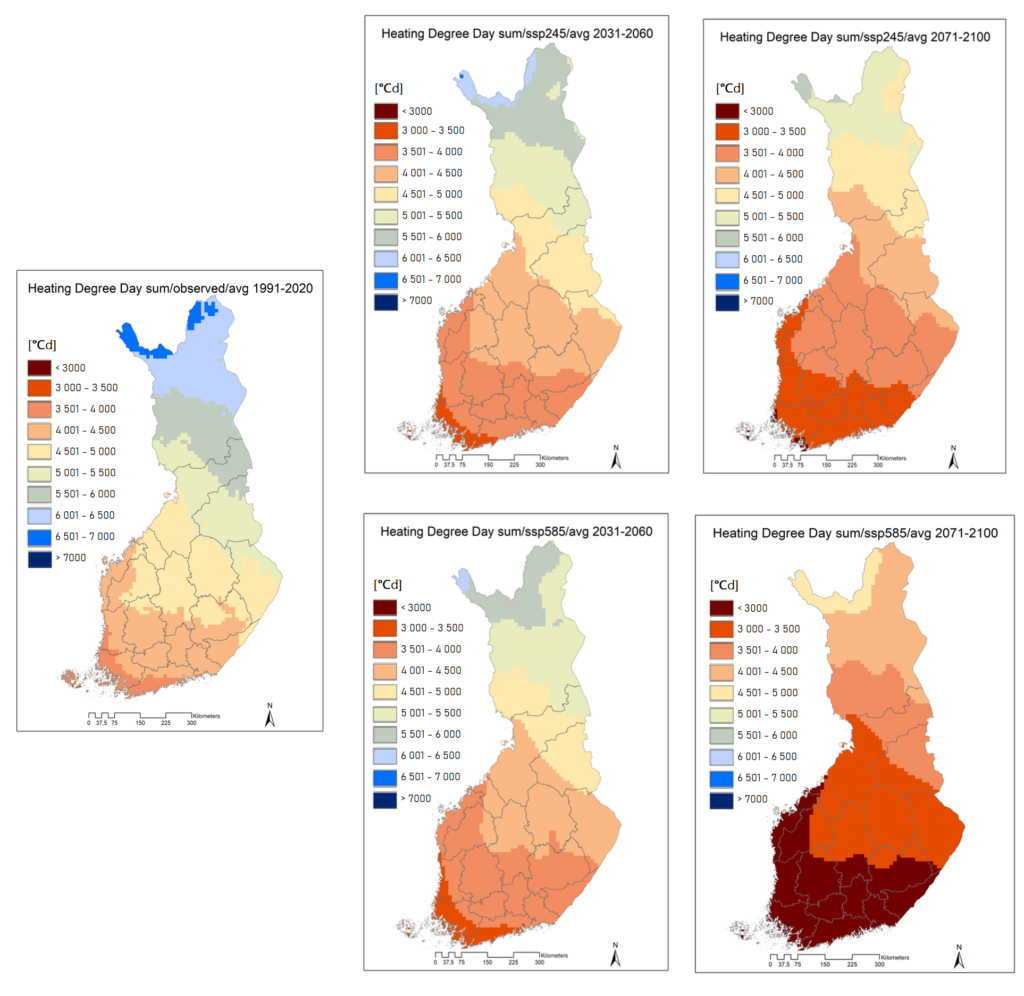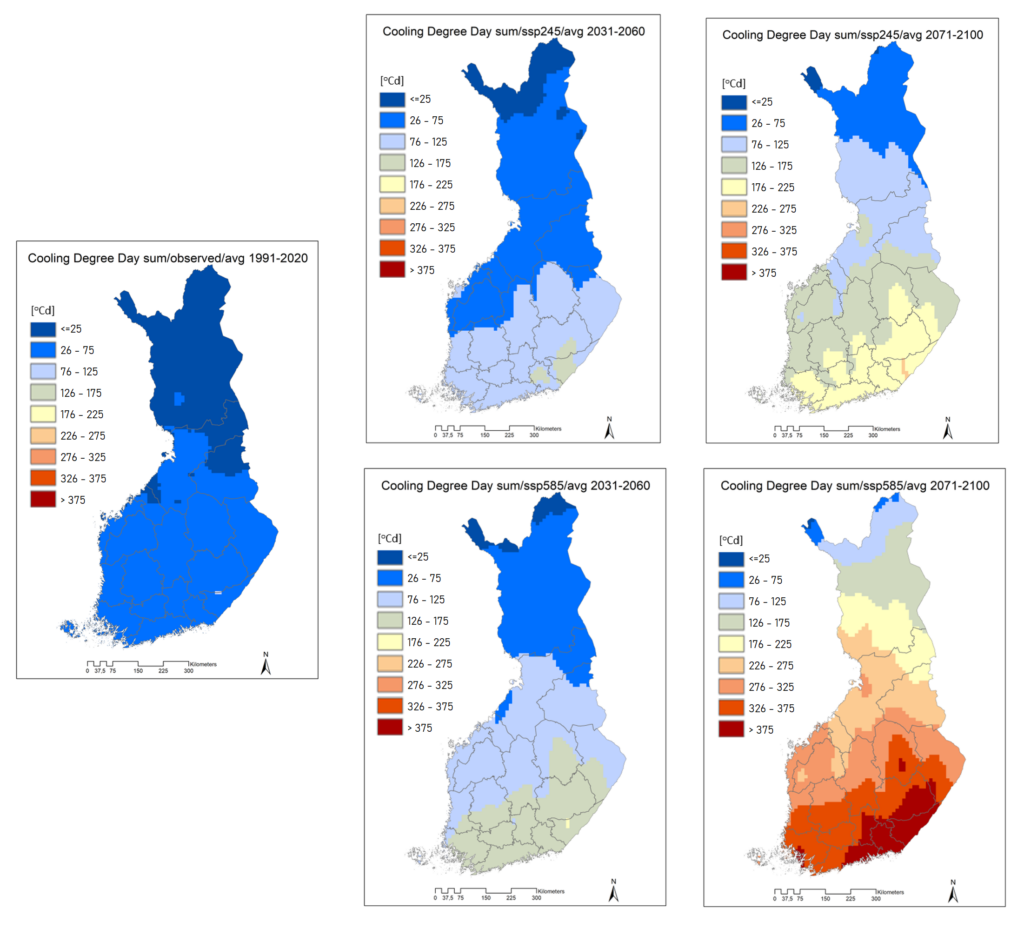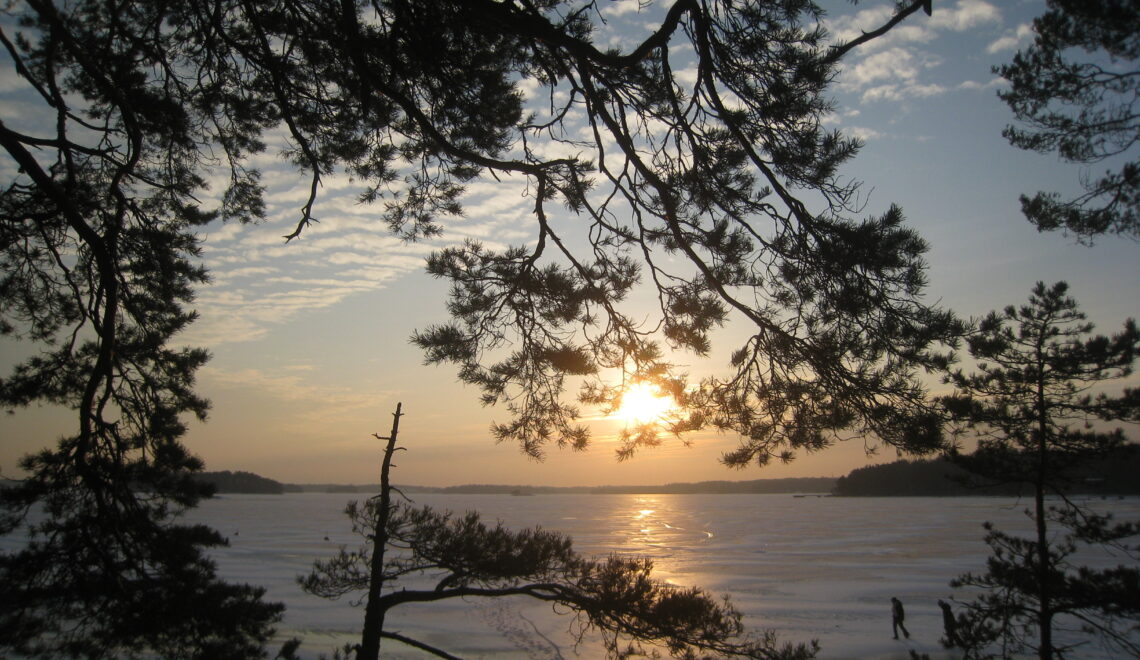The ongoing climate change will lead to decreases in heating energy demand during the cold season but, on the other hand, to an increasing demand for cooling energy in summer. Projected changes vary depending on the climate change scenario but also regionally in Finland.
PENTTI PIRINEN, REIJA RUUHELA, PAULI JOKINEN AND KIRSTI JYLHÄ
Finnish Meteorological Institute
Introduction. In Finland, the annual mean temperature is projected to increase nearly 6 ℃ in the high-emission scenario (SSP5-8.5) and nearly 4 ℃ in the moderate emission scenario (SS2-4.5) by the end of the century based on 28 CMIP6 global climate models (Ruosteenoja and Jylhä, 2021). The temperature will increase more in winter months than in summer. Geographically the temperature will increase in northern Finland more than in southern Finland in winter. Because of the warming, both heating and cooling energy demand will be impacted. A previous spatial assessment on impacts of climate change on heating degree days (HDD) and cooling degree days (CDD) in Finland was conducted based on CMIP3 model runs (Pirinen et al. 2014). Here we update the assessment based on CMIP6 climate change scenarios.
Methods. In this study we used daily mean temperature (Tday) data from five CMIP6 models that constitute a representative sub-set of the 28 models used in Ruosteenoja and Jylhä (2021). The models produce virtually the same multi-model mean values for annual and seasonal mean temperature change as the whole ensemble of 28 models. Inter-model scatter in projected long-term mean warming agrees as well (Ruosteenoja, 2022, personal communication). Moreover, there is a good inter-ensemble accordance in the simulated changes of the temporal fluctuations of the daily mean temperatures both in winter and summer. The selected models are as follows: MPI-ESM1-2-HR (parallel run #1), CMCC-CM2-SR5 (#1), GFDL-ESM4 (#1), CNRM-CM6-1 (#3) and CanESM5 (#4). The SSP2-4.5 and SSP5-8.5 greenhouse gas scenarios were employed to represent moderate and large projected changes in climate. Tday data of the selected models were first bias-adjusted using the E-OBS gridded dataset (Haylock et al. 2008), as documented by Ruosteenoja and Jylhä (2023). This data in a grid of 0.25 degrees was further bilinearly regridded onto a 10km*10km grid for a geographical area of Finland (R Raster-package).
For each grid point, heating degree days (HDD) and cooling degree days (CDD) were calculated from the daily mean temperature data using 17 ℃ as a base temperature (effective indoor temperature) for HDD and 18 ℃ for CDD.
(1) HDD = 17 – Tday, if Tday < Tthres,
where Tthres is a threshold value defining need for heating. In autumn the heating period in Finland is traditionally considered to begin when daily mean temperature decreases below 12 ℃. In spring the threshold for end of the heating period is 10 ℃ (Vajda et al, 2004; Jylhä et al, 2015).
(2) CDD = Tday – 18, if Tday > Tthres,
where Tthres = 18 ℃ is a threshold value defining need for cooling. CDD was calculated for the warm season from May to September.
Annual values were summed up from the daily HDD and CDD values, and the values for the various 30-year periods were averages of these annual values.
The HDD and CDD for present climate normal period (1991-2020) are calculated from FMI gridded data (Aalto et al. 2016) that is derived from the observations at FMI weather stations.
Results. The temporal evolvement of HDD in the two scenarios are presented in Figure 1. In the current climate the HDD varies from less than 4000 ℃d in southwestern Finland to about 6500 ℃d in northern Lapland. By the middle of the century, the heating demand will decrease in both scenarios by about the same amount, about 500 ℃d, and the HDD will vary from 3500 ℃d in southwestern Finland to 6000 ℃d in northern Lapland. The two scenarios differ substantially towards the end of the century. In the moderate emission scenario, the HDD will decrease less than in the high emission scenario and will vary from 3000 ℃d in the southwestern to 5500 ℃d in the northwestern part of the country in the end of the century. In the high emission scenario, the HDD will be less than 3000 ℃d in southern Finland and about 5000 ℃d in Northern Lapland.
Similarly, the temporal evolvement of CDD in the two scenarios is presented in Figure 2. In Finland, the cooling energy demand in general is much smaller than the heating demand. In the current climate the CDD during the summer is less than 100 ℃d in the whole country. Gradually the cooling demand is expected to increase and by the middle of the century it is projected to vary on average between 25 ℃d in northern Finland and 175 ℃d in southern Finland. By the end of the century in the high emission scenario CDD will be nearly 400 ℃d in southern Finland but still less than 200 ℃d on average in the moderate emission scenario. Worth noting that this analysis does not properly capture the urban heat island effect and therefore the impact of urban heat island on heating or cooling demand.
Conclusions. Our results show substantial changes in HDD and CDD in Finland during this century both in moderate and high emission scenarios, indicating a decreasing energy demand during cold months and increasing energy demand in summer. However, cooling energy demand will remain small compared to heating energy demand even at the end of the century. These outcomes should be considered in climate change mitigation and adaptation measures to support sustainable urban planning and building.


Data. HDD and CDD data are available by request from the FMI climate service, ilmastopalvelu@fmi.fi or climateservice@fmi.fi.
Acknowledgements. The study contributes to the FINSCAPES (No. 342561) and LEGITIMACY (No. 335562) projects funded by the Research Council of Finland, and the Smartland (327803) project funded by the Strategic Council of Finland. We also want thank Dr Kimmo Ruosteenoja for his assistance in selecting the climate change model runs for this study.
References
Aalto, J., and Coauthors, 2016: New gridded daily climatology of Finland: Permutation-based uncertainty estimates and temporal trends in climate. J. Geophys. Res. Atmos., 121, 3807–3823, https://doi.org/10.1002/2015JD024651.
Haylock, M. R., and Coauthors, 2008: A European daily high-resolution gridded data set of surface temperature and precipitation for 1950–2006. Journal of Geophysical Research, 113, D20119, https://doi.org/10.1029/2008JD010201.
Pirinen, P., and Coauthors, 2014: Ilmastonmuutos ja lämmitystarveluku paikkatietoarvioina Suomessa. Ilmatieteen laitos, Raportteja 2014:3. [Climate change and heating degree days in Finland – spatial assessment] http://hdl.handle.net/10138/135722.
Jylhä, K., and Coauthors, 2015: Hourly test reference weather data in the changing climate of Finland for building energy simulations, Data in Brief, 4, 162-169, https://doi.org/10.1016/j.dib.2015.04.026.
Ruosteenoja, K., and K. Jylhä, 2021: Projected climate change in Finland during the 21st century calculated from CMIP6 model simulations. Geophysica 56, 39–69, https://www.geophysica.fi/pdf/geophysica_2021_56_1_039_ruosteenoja.pdf.
Ruosteenoja, K., and K. Jylhä, 2023: Average and extreme heatwaves in Europe at 0.5–2.0 ℃ global warming levels in CMIP6 model simulations. Clim Dyn 61, 4259-4281, https://doi.org/10.1007/s00382-023-06798-4
Vajda, A., and Coauthors, 2004: An estimate about the influence of climate change on heating energy demand in Hungary, Romania and Finland. Idojárás, 108, 123-140.
HOW TO CITE THIS ARTICLE:
Pirinen P., Ruuhela R., Jokinen P., and Jylhä K., 2024: Future Scenarios for Heating and Cooling Degree Days in Finland, FMI’s Clim. Bull. Res. Lett., [preprint], https://doi.org/10.35614/ISSN-2341-6408-IK-2024-05-RL
CITATION INFORMATION:
Authors: Pentti Pirinen, Reija Ruuhela, Pauli Jokinen and Kirsti Jylhä
Received: December 25, 2023
Accepted: August 19, 2024
First online: October 17, 2024
Published: coming, Fall 2024
Journal: FMI’s Climate Bulletin Research Letters
Volume: 6
Issue: 1
Pages: X-X
DOI: https://doi.org/10.35614/ISSN-2341-6408-IK-2024-05-RL
Header Image: Adobe Stock




